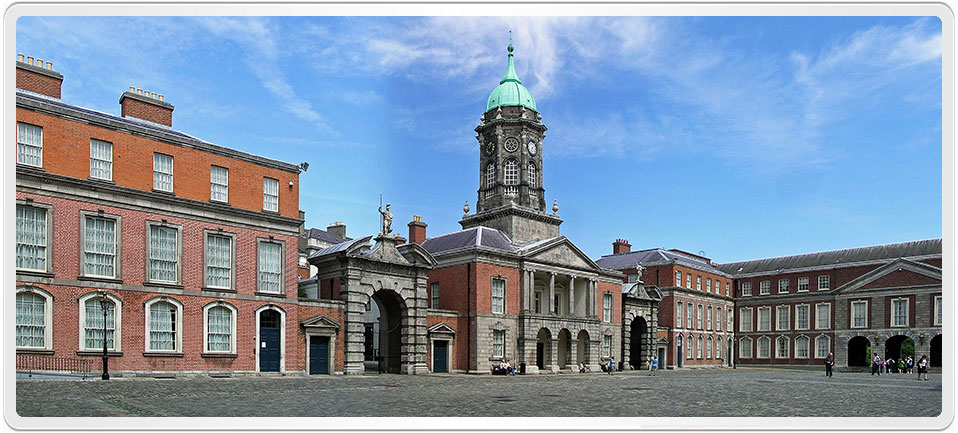
2nd Great Grandparents – Paternal mother’s line Johnson Family
Bernard O’Neill was born in 1815 in Dublin, Ireland, his father, Berd, was 29 and his mother, Elinor, was 25. Twenty years later in 1835 Mary Ryan was born in Tipperary, Ireland, her father, John, was 27, and her mother, Mary, was 25. Bernard and Mary married in 1862 in Picton, New South Wales, Australia. They had ten children in 17 years. Bernard died on 10 July 1896, in Picton, New South Wales, Australia, having lived a long life of 81 years. Mary died on 5 December 1910, in Summer Hill, New South Wales, Australia, having lived a long life of 75 years, and was buried in Rookwood, New South Wales, Australia.
 Births
Births
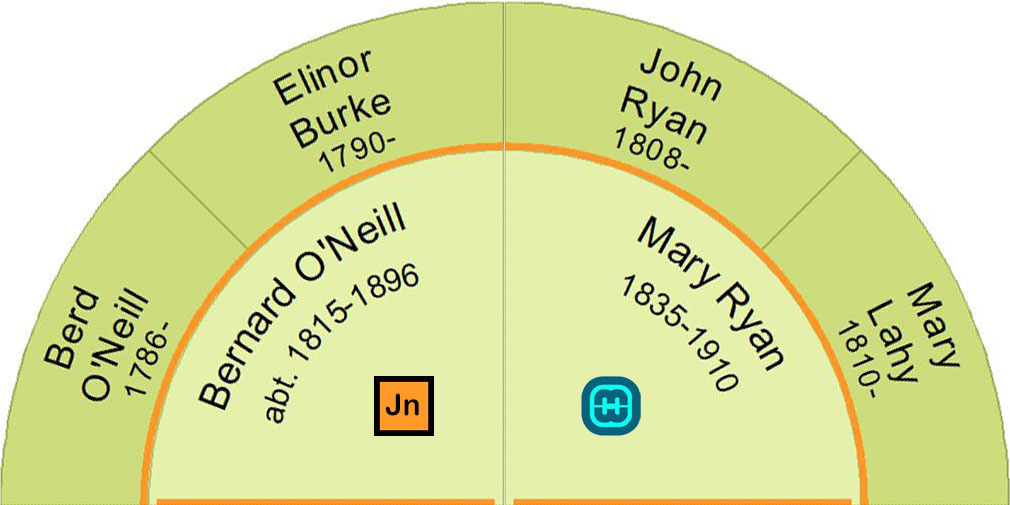
Bernard O’Neill was born in 1815 in Dublin, Ireland, to Elinor Burke, aged 25, and Berd O’Neill, aged 29.
Bernard was baptised in the St Michael and John Irish Catholic Church, Dublin City, Dublin, Ireland on 16 April 1815. His Godparents were John Conway and Mary Burke.
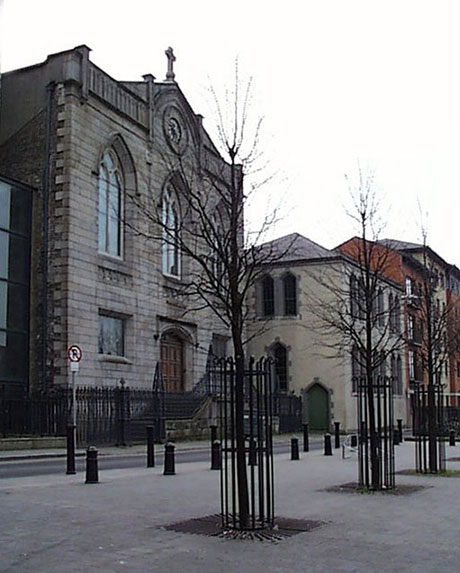
Mary Ryan was born in 1835 in Tipperary, Tipperary, Ireland, to Mary Lahy, aged 25, and John Ryan, aged 27.
Mary was baptised in the Irish Catholic Diocese of Cashel and Emly at Loughmore and Castleiny on 15 August 1835. Her sponsors were Daniel Cormick & Catherine Shardhen.
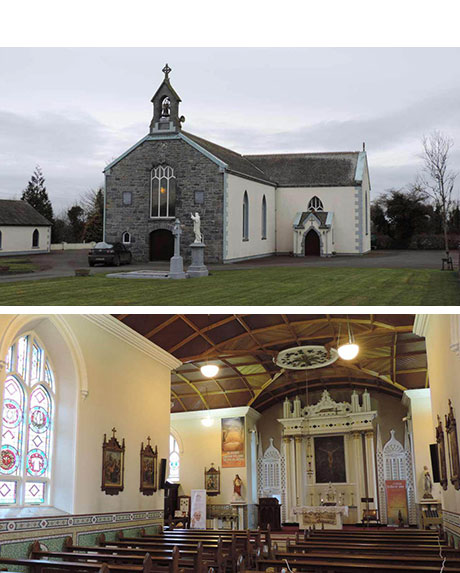
The Many Names of Bernard O’Neill
- Examples of names allegedly used by Bernard included: Neill, O’Neil, O’Neill, Neal, and Neale.
- How many different surnames can a person like Bernard have?
- Were the various surnames utilized by Bernard actual aliases used by him to avoid detection?
- Was Bernard able to read and/or write?
It is believed that Bernard could neither read or write. Therefore any existing documents that included the names Neill, O’Neil, O’Neill, Neal, or Neale were probably written by a third party interpreting what they had heard verberally.
At the time of his baptism on 16 April 1815, in the St Michael and John Irish Catholic Church, he was clearly baptised as Bernard O’Neill. This webpage will always use the surname O’Neill, when referring to Bernard and his family.
1828 From Dublin, Ireland to Picton, New South Wales
Bernard O’Neill, aged 13 in 1828, was an errand boy in Dublin City, Ireland. Already he had two former convictions in the Irish courts. But now Bernard was charged with the crime of “Picking Pockets”. The court found him guilty and sentenced him to 7 years detention.
Initially Bernard was transferred to Newgate Prison, Dublin and then to the prison hulk, “Essex” in Kingstown harbour, preparatory to him being transported by Convict Ship to New South Wales. The following image shows Newgate Prison, Dublin as well as Ireland’s only other prison hulk “Surprise” – an image of the “Essex” was not available.
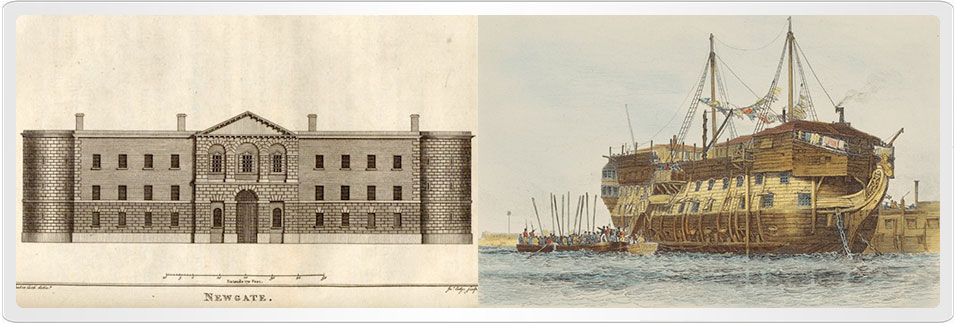
The Ship Ferguson departed Dublin on 16 November 1828. Bernard and the other prisoners were already in a low state of health when they embarked and bad weather in the early part of the voyage caused many of them to suffer sea sickness. By early March 1829 both prisoners and their soldier guards suffered from a deficiency of vitamin C causing Scorbutus. The ships surgeon, Charles Cameron, did not consider most of them serious.
On 26 March 1829 the Ship Ferguson arrived in Sydney Cove. Two prisoners had died on the voyage out. The ships surgeon noted on this day that fresh beef and vegetables being daily supplied to the prisoners, would improve the general health of the scorbutic patients rapidly. Two days later 28 March 1829 a Convict Muster was held by the Colonial Secretary.
Bernard O’Neill, aged 14, was assigned to Carters’ Barracks. The Barracks on Pitt Street, running along what is close to contemporary Eddy Avenue, comprising several buildings built to house convict gangs working as carters on the brick fields. It was also used as a boys’ barracks. The buildings were demolished by 1901 to make way for the development of Central Railway Station.
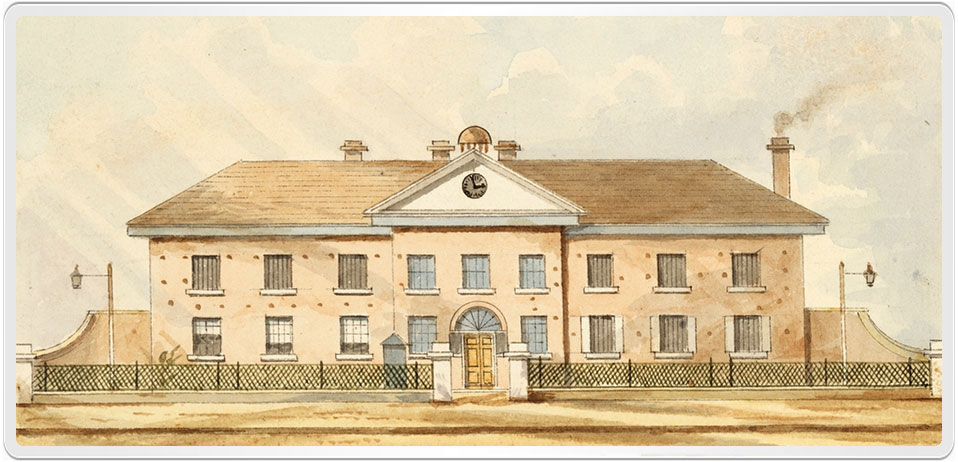
Bernard O’Neill, aged 20, having served his sentence of 7 years, received his Certificate of Freedom on 11 September 1835. He was described as a labourer, 5 ft 4 in (165 centimetres) tall, dark complexion with dark brown hair and brown eyes. He also had a scar over his right eye as well as a large scar outside the lower part of his right arm.
By the 1840’s he was working in Picton, New South Wales. In the early 1860’s Bernard worked as a hired servant to Thomas Mulholland, farmer of Abbotsford, who found him neglectful of his duties.
1855 From Tipperary, Ireland to Picton, New South Wales
In June 1854, Mary Ryan’s elder sister Ellen was living in New South Wales, when she sponsored the passage of Mary as an “Assisted Immigrant” to Sydney. A total deposit of £8 0s 0d was made, ensuring that her jouney was subsidized. The cost breakdown included an assisted passage cost of £5.0.0 and £3.0.0 for Mary’s benefit before embarkation. Further information can be found in the New South Wales, Australia, Immigration Deposit Journals, 1853-1900.
Mary Ryan, aged 20, travelled from Tipperary, Ireland and boarded the Ship Himalaya at the Port of London. The Himalaya arrived in Sydney, New South Wales, on 10 May 1855.
Soon after arriving to Sydney, Mary was employed as a servant in Picton, New South Wales. She probably met Bernard at this time. The construction of the railway line occurred during this period and its subsequent opening happened after their marriage in 1862. The arrival of trains was a big event and for some time Picton was the terminus of the Southern Line. Four years later the line was extended to Mittagong.
 Marriage
Marriage
Bernard O’Neill, Bachelor, married Mary Ryan, Spinster. on 3 March 1862 at the Roman Catholic Church in Picton, New South Wales, Australia. Both declared that they were Members of the Roman Catholic Church. Mary Ryan signed the Marriage Register and Bernard O’Neill used his X mark.

Following their marriage in 1862 Bernard and Mary were employed and living at “Stargard”, Rümkers Island, Stonequarry Creek (Picton). Their first three children, Michael, Mary and Annie, were born at “Stargard” between November 1862 and 1865.
Following Annie’s birth in 1865, Bernard and his wife Mary moved to Abbotsford Farm, Picton, where they both worked and lived. All of their remaining seven children were born at “Abbotsford”.

Ruins of “Abbotsford” with the town of Picton in the background
Information about “Stargard” Farm
Carl Ludwig Rümker (1788-1862), astronomer, arrived in Sydney in 1821 and worked at a private Parramatta Observatory where on 2 June 1822 he rediscovered Encke’s comet. Thomas Brisbane, Governor of New South Wales bestowed on Rümker a grant of 1000 acres (405 ha) at Stonequarry Creek (Picton). One year later, in June 1823, Rümker retired to his farm which he had named “Stargard” after his birthplace in Germany.
In 1829 he went to London to obtain new instruments for the Parramatta observatory but was finally dismissed from British government service in June 1830. He never returned to his farm.
Rümker returned to Europe in 1830 and took charge of the new Hamburg Observatory. His chief work was concerned with the cataloging of stars: a preliminary catalogue of the stars of the Southern Hemisphere was published in 1832 at Hamburg
He died at Lisbon on 21 December 1862 and was buried in the churchyard of the English church at Estrella. His land was granted to Charles Luis Rümker.
Information about “Abbotsford” Farm
Abbotsford, a colonial Georgian brick house, is a heritage-listed former farm and residence. It is located at Oaks Road in the outer south-western Sydney suburb of Picton, in the Wollondilly Shire local government area of New South Wales.
It was built from 1822 to 1908. Abbotsford was added to the NSW State Heritage Register on 2 April 1999. The block is covered with thick vegetation and grass along with several trees. The house was a remarkable survival of a farmhouse from an early period of Australia’s settlement.
However neglect, and two separate fires has led to its state of dereliction. Information about the home is available on Wikipedia. The main components of “Abbotsford” are:
- House (now ruins)
- Trees, Gardens & Grounds
- Underground Water Storage Tank
- Cottage & Brick Outhouse (now ruins)
The remaining seven children of Bernard O’Neill and Mary Ryan were Margaret, Catherine, Elizabeth, Unnamed Male, John, Patrick and Bridget. All were born at “Abbotsford” between 1866 and 1880.
Children of Bernard and Mary
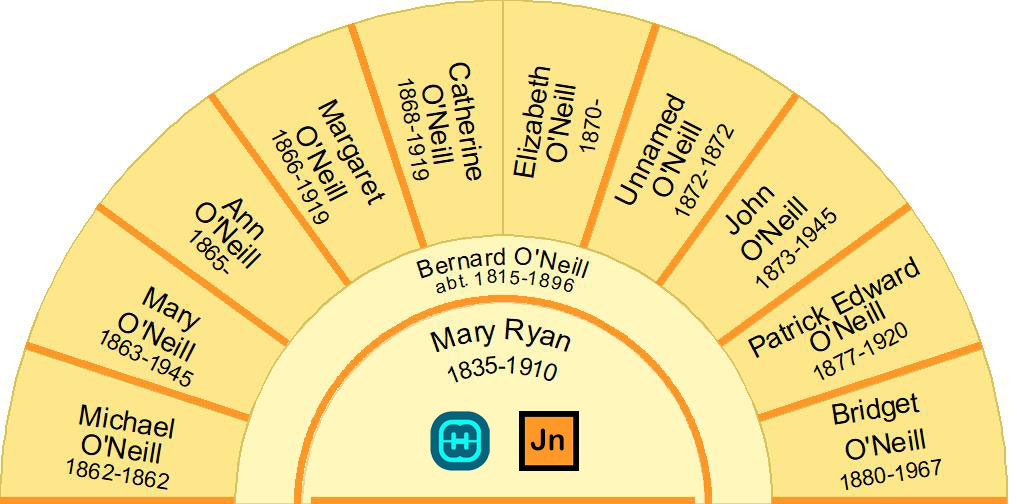
- Michael O’Neill [25 Nov 1862-19 Dec1862]
- Mary O’Neill [1863-1945] spouse James Johnson
- Annie O’Neill [1865-?] spouse Robert Arthur Proctor
- Margaret O’Neill [1866-1919] spouse Matthew John Cray
- Catherine O’Neill [1868-1919] spouse George Henry Davies
- Elizabeth O’Neill [1870-?] spouse John Sarchfield
- Unnamed Male Infant O’Neill [1872-1872]
- John O’Neill [1873-1945] spouse Lavinia Mallows
- Patrick Edward O’Neill [1877-1931] spouse Mary Cleary
- Bridget O’Neill [1880-1967] spouse William John Coulter
Mary O’Neill, aged 18. was our direct ancestor, she married James Johnson, aged 26, in October 1882 at the Picton Roman Catholic Church, New South Wales.

Bernard O’Neill, labourer, aged 81, died on 10 July 1896 at Menangle Street, Picton. His death was caused by retention of urine and debility. He was buried on 12 July 1896 in the Roman Catholic Cemetery, Upper Picton.
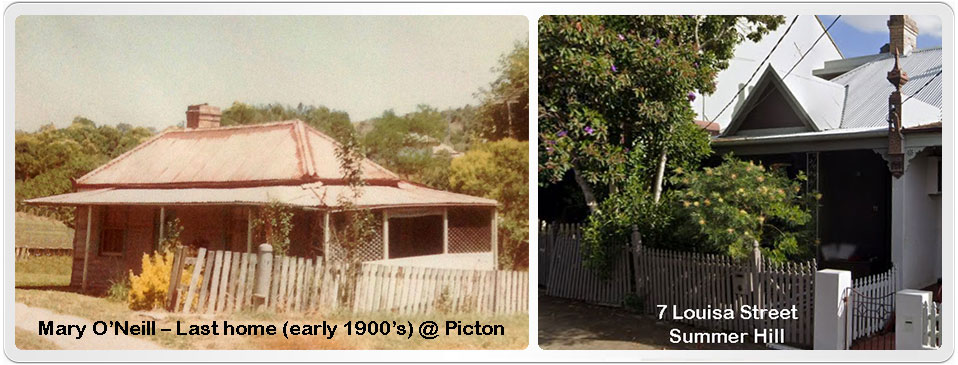
Mary O’Neill née Ryan, aged 78, died on 5 December 1910 at 7 Louisa Street, Summer Hill. Her death was caused by Diabetes Mellitus. She was buried on 7 December 1910, in the Roman Catholic Cemetery, Rookwood.
Your comments are always welcome
Comments can be left by clicking the blue “Hall & Johnson” heading at the top of this page.
Reviewed and updated – 31 August 2022
